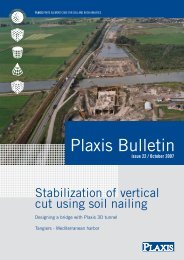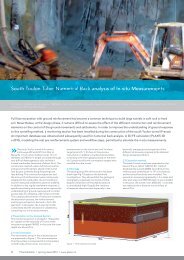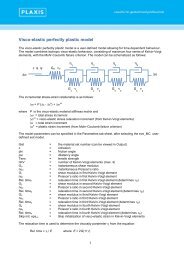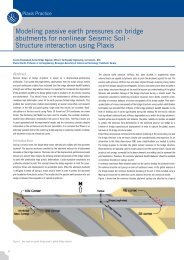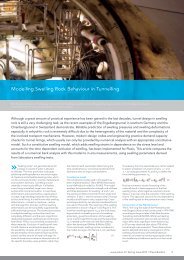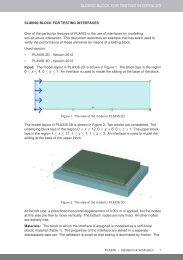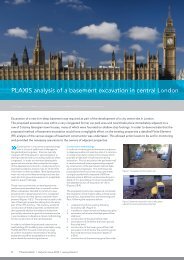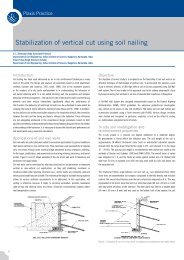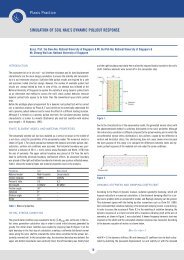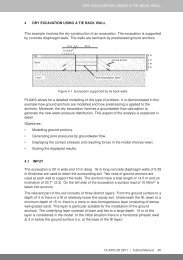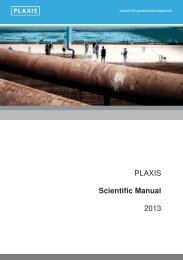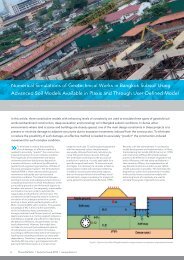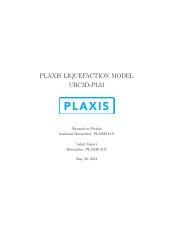Nicoll Highway Collapse: Evaluation of Geotechnical ... - Plaxis
Nicoll Highway Collapse: Evaluation of Geotechnical ... - Plaxis
Nicoll Highway Collapse: Evaluation of Geotechnical ... - Plaxis
You also want an ePaper? Increase the reach of your titles
YUMPU automatically turns print PDFs into web optimized ePapers that Google loves.
as the excavation proceeds to level 10 (Fig. 11b). Both analyses predict minimal change in the maximum<br />
wall deflection (100mm and 210mm for A and B, respectively) for excavations below level 7.<br />
This behavior can be understood through further comparison <strong>of</strong> results from B[GIM] and GIM*.<br />
These two cases show very similar wall deflections at level 7. However, GIM* predict a significant<br />
increment in wall deflection below 81mRL for excavation to the final formation. This behavior reflects<br />
the refinement in the selection <strong>of</strong> undrained strength properties in the lower Estuarine and Old<br />
Alluvium (SW-2) layers and the full mobilization <strong>of</strong> the resistance <strong>of</strong> the lower JGP.<br />
The EBC case can be interpreted as a worst credible interpretation <strong>of</strong> the undrained shear strength<br />
pr<strong>of</strong>ile as it implies underconsolidation <strong>of</strong> the Lower Marine Clay. Figure 11a shows that the EBC<br />
pr<strong>of</strong>ile generates an additional 50mm <strong>of</strong> wall deflection at level 7 and up to 90mm additional deflection<br />
at the final formation elevation. These results confirm that small variations in the undrained shear<br />
strength within the LMC (and lower E) layers can produce significant changes in computed wall deflections.<br />
The same set <strong>of</strong> analyses have been used to investigate the mobilization <strong>of</strong> the passive resistance<br />
within the JGP layers. Figure 12a compares the predicted axial force (F x ) in the upper and lower JGP<br />
layers with the design load capacities using Methods A and B as functions <strong>of</strong> the excavation depth.<br />
(with formation elevation for levels 2-9). The computed loads are compared with the design capacity<br />
based on the theoretical passive earth pressures stresses (JGP has design s u = 300kPa). The Figure<br />
presents results for analysis case A (2.6m thick lower JGP) and B[GIM*]. The results show very<br />
clearly that Method B mobilizes the passive resistance <strong>of</strong> the JGP layers at much higher formation elevations<br />
than Method A. For the lower JGP, Method B predicts that the design capacity becomes fully<br />
mobilized for excavation below level 6, while Method A calculations show this condition only occurs<br />
below level 9.<br />
Formation Elevation, RL (m)<br />
100<br />
95<br />
90<br />
85<br />
80<br />
Upper<br />
JGP<br />
(1.5m)<br />
Theoretical Design<br />
Capacity<br />
Lower<br />
JGP (2.6m)<br />
M3-Design Analyses<br />
A<br />
B[GIM*]<br />
M3-Design Analyses<br />
A Upper<br />
Lower<br />
B[GIM*] Upper<br />
Lower<br />
75<br />
0 1000 2000 3000 4000<br />
Horizontal Force in JGP, F x<br />
(kN/m)<br />
0 50 100 150 200 250<br />
Axial Compression <strong>of</strong> JGP (mm)<br />
Notes: The theoretical horizontal passive earth pressure, σ h = σ v + xs u , where x= 2.0 – 2.3 depending on the wall<br />
adhesion.<br />
Figure 12. Effect <strong>of</strong> analysis method on mobilization <strong>of</strong> passive capacity <strong>of</strong> JGP layers<br />
Mobilization <strong>of</strong> the passive resistance <strong>of</strong> the JGP layers is correlated with the axial compression and<br />
hence, can be conveniently compared to measurements <strong>of</strong> wall deflection. Figure 12b presents the corresponding<br />
axial compression <strong>of</strong> the upper and lower JGP layers computed using Methods A and<br />
B[GIM*]. Method B shows significant deviation from Method A predictions <strong>of</strong> axial compression<br />
below level 3 for the Upper JGP and below level 6 for the lower JGP layers, respectively.<br />
Figure 13 summarizes the maximum computed loads in strut levels 6, 7 and 9 during the excavation<br />
for the four analysis cases described above (level 8 was not included as the strut was designed for<br />
maximum loads occurring during subsequent tunnel construction). These calculations incorporated the<br />
theoretical axial load and bending moment capacities <strong>of</strong> the struts and diaphragm wall used in the



